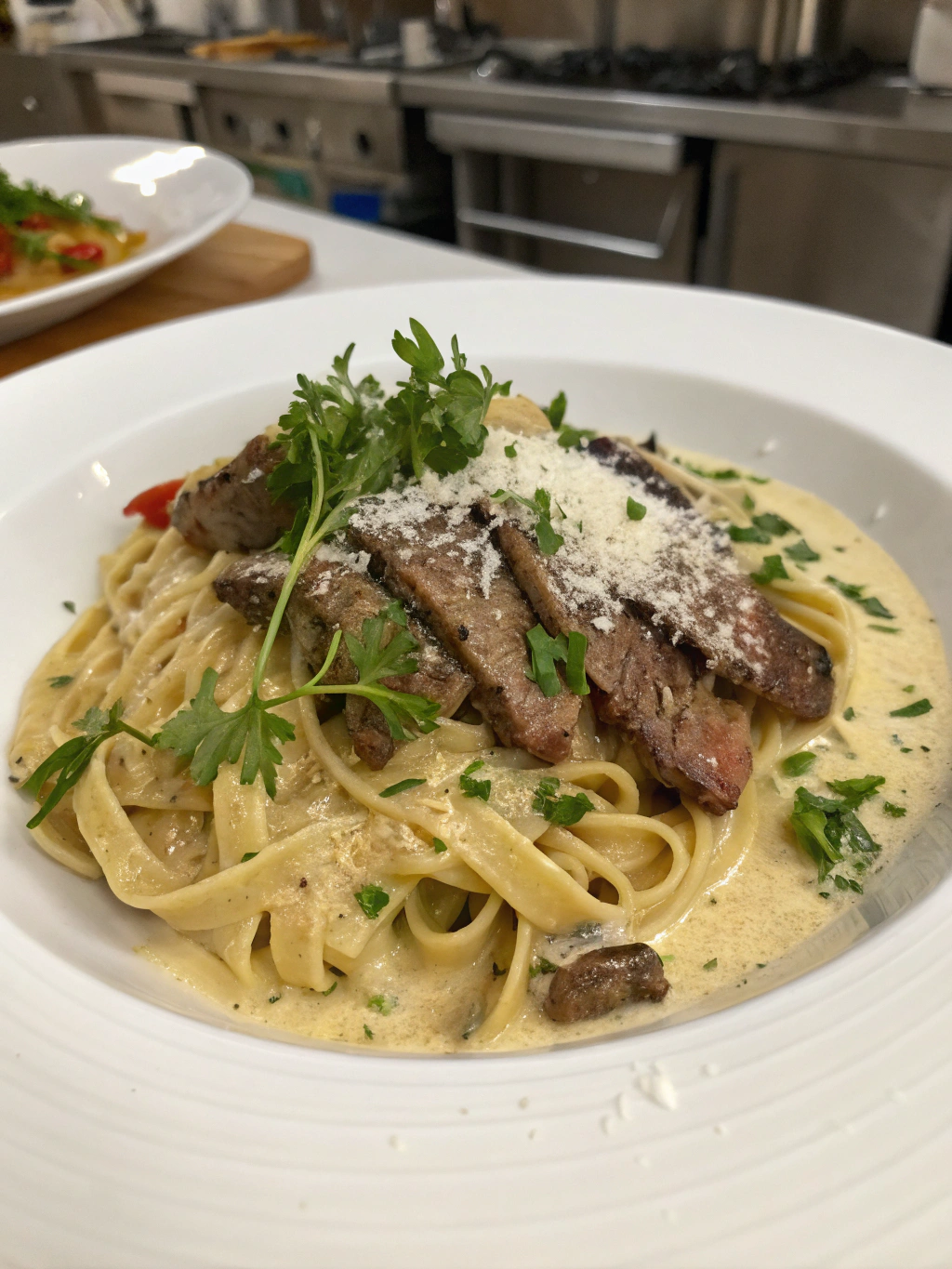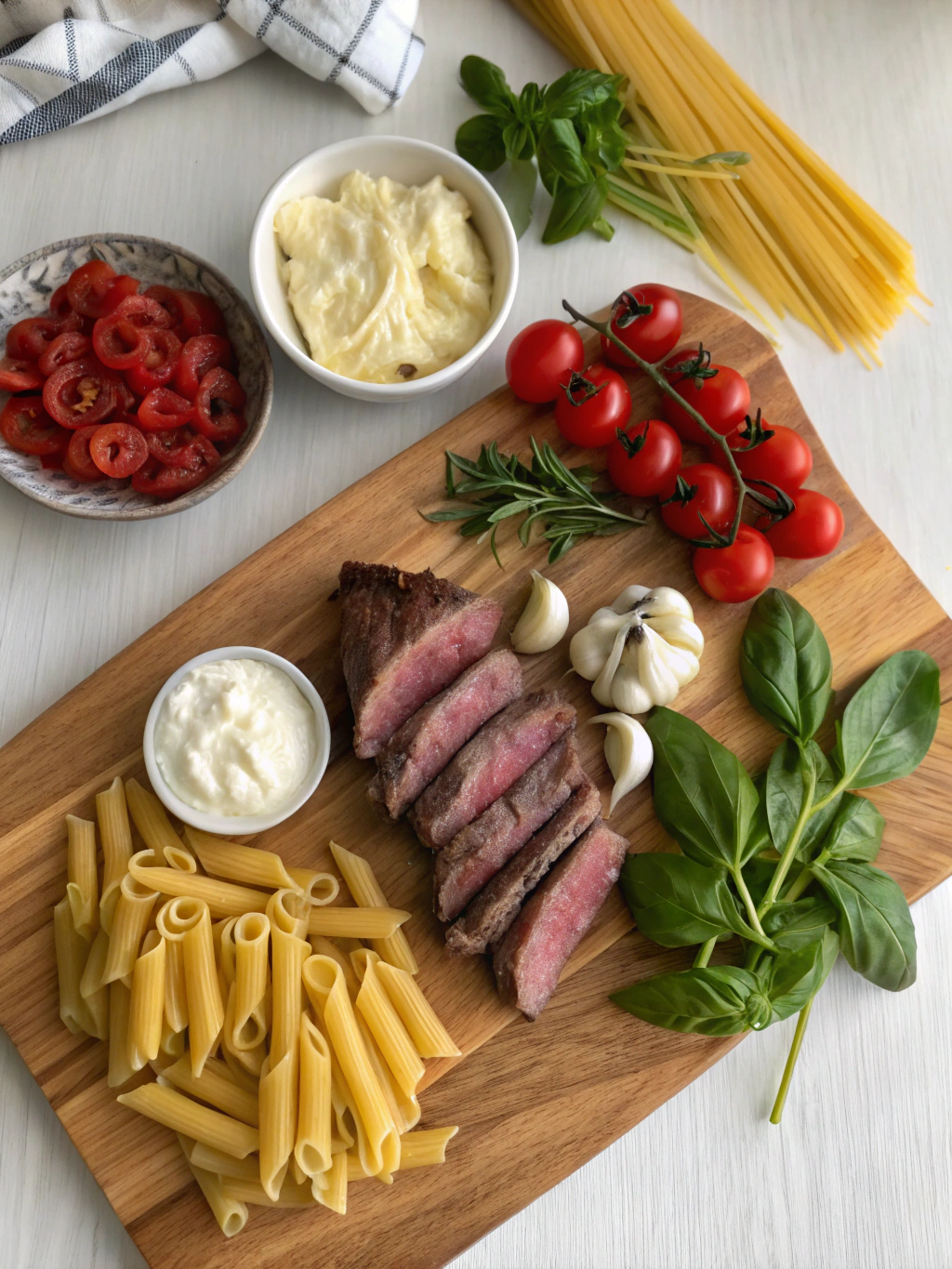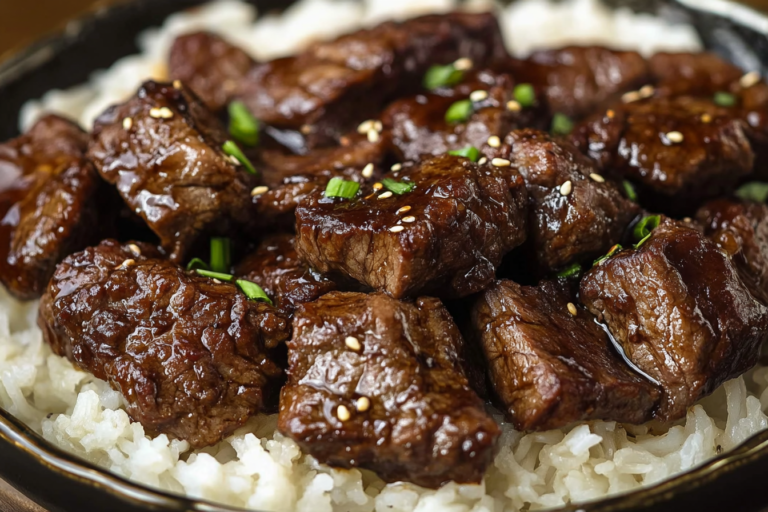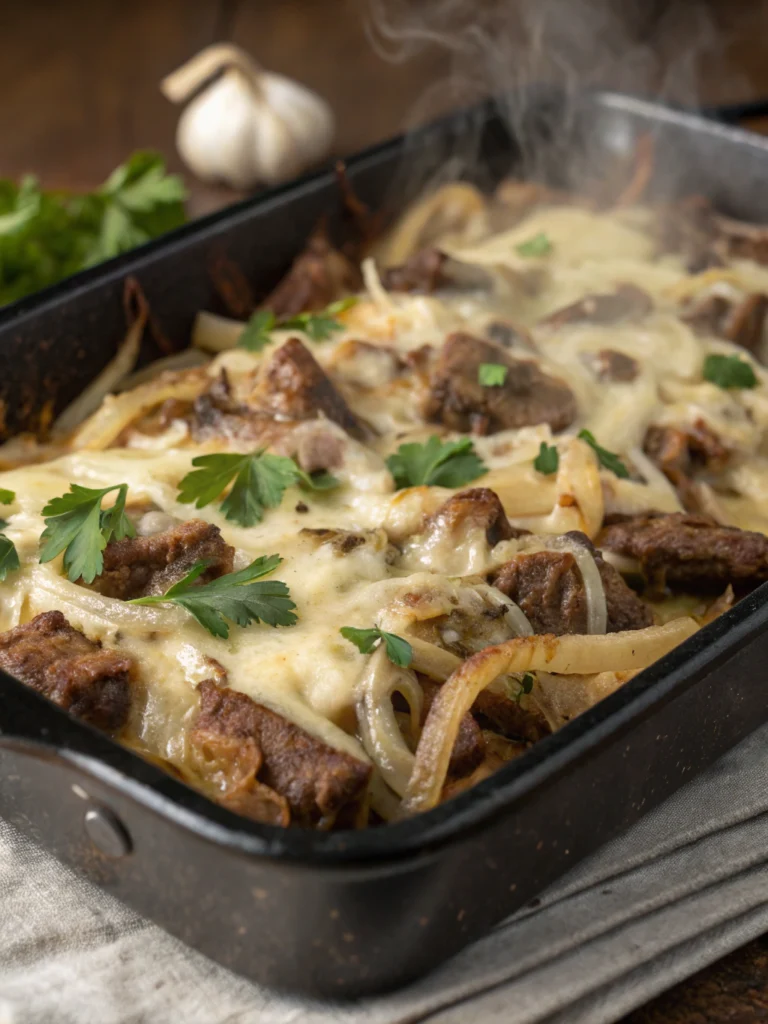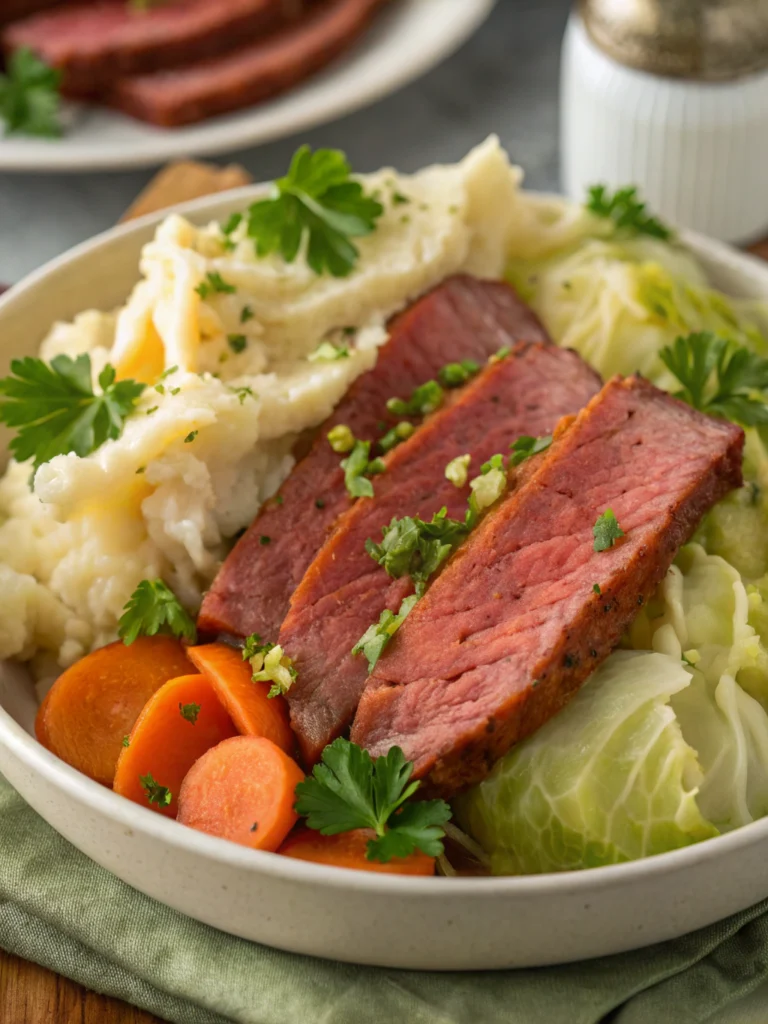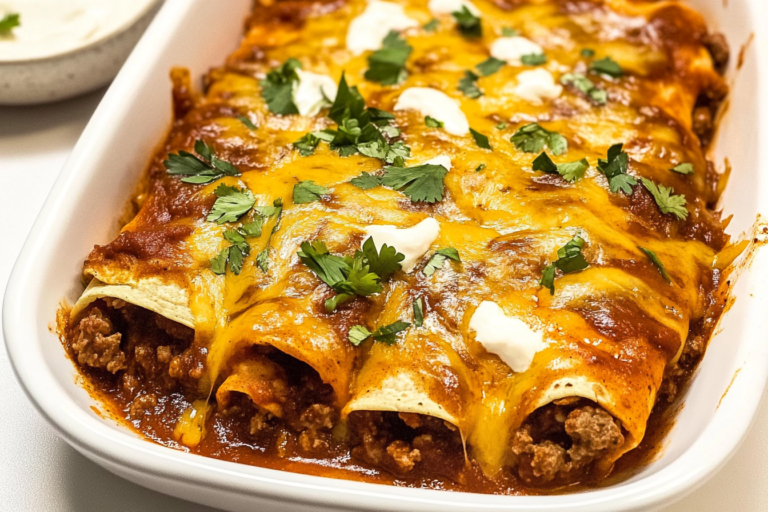Creamy Steak Pasta
A luxurious blend of tender steak strips, al dente pasta, and silky parmesan cream sauce that comes together in just 30 minutes. This restaurant-quality dish combines the heartiness of a steakhouse dinner with the comfort of homemade pasta – perfect for weeknight dinners or special occasions.
Easy Creamy Steak Pasta Recipe
There’s something incredibly satisfying about the combination of perfectly seared steak and creamy pasta that makes this Creamy Steak Pasta recipe an instant favorite in any household. This dish transforms everyday ingredients into something truly special, bringing steakhouse flavors right to your dinner table. Originally inspired by Italian-American cuisine, this comforting pasta dish has evolved to become a perfect year-round meal – hearty enough for winter evenings yet not too heavy for a spring or summer dinner on the patio.
THIS RECIPE:
- Combines tender, juicy steak with a silky cream sauce that clings perfectly to pasta
- Requires minimal prep work with maximum flavor impact
- Uses common pantry ingredients alongside fresh components
- Can be customized with seasonal vegetables or different protein options
| Recipe Details | Information |
|---|---|
| Prep Time | 10 minutes |
| Cook Time | 20 minutes |
| Total Time | 30 minutes |
| Servings | 4 people |
| Yield | 4 bowls of pasta |
This Creamy Steak Pasta comes together in just 30 minutes, making it perfect for busy weeknights when you crave something indulgent without the fuss. What makes this recipe truly special is how the richness of the cream sauce balances perfectly with the savory steak and al dente pasta, creating a satisfying dish that feels like a restaurant meal but requires just a handful of ingredients and simple techniques.
Ingredients for Creamy Steak Pasta
The quality of ingredients makes all the difference in this Creamy Steak Pasta. Since the recipe has relatively few components, opt for the best quality you can find, particularly for the steak and parmesan cheese, which are the stars of this dish. Fresh herbs also make a noticeable difference in the final flavor profile.
For the Steak:
- 1 pound (450g) sirloin or ribeye steak, thinly sliced against the grain
- 2 tablespoons olive oil
- 2 teaspoons Italian seasoning
- 1 teaspoon garlic powder
- Salt and freshly ground black pepper, to taste
For the Pasta and Sauce:
- 12 ounces (340g) fettuccine or pappardelle pasta
- 2 tablespoons butter
- 4 cloves garlic, minced
- 2 shallots, finely diced
- 1 tablespoon all-purpose flour
- 1 cup (240ml) beef broth
- 1½ cups (360ml) heavy cream
- 1 cup (100g) freshly grated Parmesan cheese
- ½ teaspoon red pepper flakes (optional)
- 2 tablespoons fresh parsley, chopped
- 1 tablespoon fresh basil, chopped
For Garnish:
- Additional grated Parmesan cheese
- Fresh parsley, chopped
- Freshly ground black pepper
| Ingredient Category | Recommended Quantity | Quality Tips |
|---|---|---|
| Steak | 1 pound sirloin or ribeye | Choose well-marbled cuts with some fat for flavor; room temperature before cooking |
| Pasta | 12 ounces fettuccine or pappardelle | Use egg pasta for richness; quality dried pasta is better than budget options |
| Cheese | 1 cup freshly grated Parmesan | Buy a block and grate yourself; pre-grated contains anti-caking agents |
| Cream | 1½ cups heavy cream | Higher fat percentage (at least 36%) creates silkier sauce |
| Herbs | 3 tablespoons mixed fresh herbs | Fresh herbs provide brighter flavor than dried; store with stems in water |
How to Make Creamy Steak Pasta
Creating this luxurious pasta dish involves three main components: cooking the pasta to perfection, searing the steak for optimal flavor, and creating a silky cream sauce that brings everything together. The key to success is timing each element so they come together seamlessly at the end.
Prepare the steak:
- Season steak slices with salt, pepper, Italian seasoning, and garlic powder
- Allow to sit at room temperature for 15 minutes while preparing other ingredients
Cook the pasta:
- Bring a large pot of salted water to a rolling boil
- Add pasta and cook until al dente according to package directions (usually 8-10 minutes)
- Reserve 1 cup of pasta water before draining
- Drain pasta but do not rinse
Sear the steak:
- Heat olive oil in a large skillet over medium-high heat until shimmering
- Add steak slices in a single layer (work in batches if necessary to avoid overcrowding)
- Sear for 1-2 minutes per side until browned but still slightly pink inside
- Transfer to a plate and cover with foil to keep warm
Make the cream sauce:
- In the same skillet, reduce heat to medium and add butter
- Add shallots and cook until softened, about 2 minutes
- Add minced garlic and cook until fragrant, about 30 seconds
- Sprinkle flour over the mixture and stir constantly for 1 minute
- Slowly pour in beef broth while whisking to remove any lumps
- Add heavy cream and bring to a gentle simmer
- Cook for 3-4 minutes until slightly thickened
- Stir in Parmesan cheese until melted and sauce is smooth
- Add red pepper flakes if using
Combine everything:
- Return steak to the skillet along with any accumulated juices
- Add drained pasta to the sauce and toss gently to coat
- If sauce is too thick, add reserved pasta water a little at a time
- Stir in fresh herbs and season with additional salt and pepper if needed
- Cook for 1-2 minutes more until everything is hot and well combined
Allow the pasta to rest for 2-3 minutes off the heat before serving. This gives the sauce time to thicken slightly and cling better to the pasta and steak.
Tips for Making Creamy Steak Pasta
Pro tip: For the most tender results, slice your steak thinly (about ¼ inch thick) and always cut against the grain. This shortens the muscle fibers and makes each bite more tender.
- Don’t overcook the steak – it will continue cooking slightly when added back to the hot sauce
- Salt your pasta water generously (it should taste like seawater) for properly seasoned pasta
- Use room temperature cream to prevent the sauce from breaking
- Never rinse your pasta after cooking – the starch helps the sauce adhere better
| Technique | Recommendation |
|---|---|
| Steak Searing | Use a very hot pan and don’t move the steak for at least 1 minute to develop proper crust |
| Sauce Consistency | If too thick, add pasta water; if too thin, simmer a bit longer before adding pasta |
| Pasta Cooking | Cook 1 minute less than package directions for perfect al dente finish in sauce |
| Cheese Integration | Remove pan from heat before adding Parmesan to prevent graininess |
The key to a silky smooth sauce is adding the Parmesan gradually while the sauce is warm but not boiling. High heat can cause the cheese proteins to seize, resulting in a grainy texture instead of the velvety consistency we want.
Make-Ahead Instructions
This Creamy Steak Pasta is best enjoyed fresh, but you can prepare components ahead of time to streamline the cooking process.
For meal prep up to 24 hours in advance:
- Slice and season the steak, then store in an airtight container in the refrigerator
- Dice shallots and mince garlic, storing in separate containers
- Grate Parmesan cheese and refrigerate
- Chop herbs and store in a damp paper towel inside a plastic bag
If you want to prepare the complete dish in advance:
- Cook everything according to the recipe but undercook the pasta slightly
- Store the sauce and steak separately from the pasta
- When ready to serve, heat the sauce in a large skillet, add the pasta with a splash of water, and heat until warmed through
The prepared components will stay fresh in the refrigerator for up to 2 days. I don’t recommend freezing the prepared sauce as dairy-based sauces can separate and become grainy when thawed.
Storing Leftovers
Properly stored leftovers of Creamy Steak Pasta can be enjoyed for a quick lunch or dinner in the days following preparation.
For food safety and optimal flavor:
- Allow leftovers to cool completely before storing, but don’t leave at room temperature for more than 2 hours
- Store in airtight containers in the refrigerator
- Consume within 3 days for best quality and safety
- Stir well before reheating as the sauce may separate
To reheat:
- Place in a skillet over medium-low heat
- Add a splash of milk, cream, or broth to revitalize the sauce
- Heat gently while stirring occasionally until warmed through
- Avoid microwave reheating if possible, as it can make the steak tough and the sauce oily
Freezing Creamy Steak Pasta
While cream-based pasta dishes aren’t ideal candidates for freezing, it’s possible with some adjustments if necessary.
If you must freeze this dish:
- Cook the pasta more al dente than usual, as it will soften further when reheated
- Cool the prepared dish completely before portioning into freezer-safe containers
- Leave some space in containers for expansion
- Consider freezing sauce and meat separately from pasta for better texture
- Label containers with date and contents
- Freeze for up to 1 month (quality deteriorates beyond this point)
To thaw and reheat:
- Transfer from freezer to refrigerator for 24 hours to thaw gradually
- Reheat in a skillet over low heat, adding fresh cream to revitalize the sauce
- If the sauce has separated, whisk vigorously while reheating to recombine
- Add freshly grated Parmesan and herbs after reheating to refresh flavors
Serving Suggestions
This Creamy Steak Pasta creates an impressive presentation and pairs beautifully with simple accompaniments that balance its richness.
Sides that complement Creamy Steak Pasta:
- Simple arugula salad with lemon vinaigrette
- Garlic bread or crusty Italian bread
- Roasted asparagus or broccolini
- Cherry tomatoes sautéed with garlic
For an elegant presentation, serve in warmed pasta bowls, twirling the pasta with tongs to create height. Top with additional Parmesan shavings, a sprinkle of fresh herbs, and a crack of black pepper.
Beverage pairings:
- Red wine: Medium-bodied Merlot or Chianti
- White wine: Oaked Chardonnay or Viognier
- Beer: Amber ale or wheat beer
- Non-alcoholic: Sparkling water with lemon or a crisp apple juice
Serve this dish hot, immediately after preparation, when the sauce is at its creamiest and the steak is at perfect tenderness.
FAQ
Can I use a different cut of steak for this recipe?
Yes! While sirloin and ribeye work beautifully, you can substitute strip steak, flank steak (sliced very thinly), or even tenderloin. The key is choosing a tender cut with some marbling and slicing it against the grain. Avoid stew cuts like chuck or round, which require long cooking times to become tender.
What can I substitute for heavy cream to make this lighter?
For a lighter version, replace half the heavy cream with half-and-half or whole milk. You may need to simmer the sauce slightly longer to reach the desired thickness. For a dairy-free version, unsweetened coconut cream can work, though it will add a slight coconut flavor.
My sauce is too thin. How can I thicken it?
If your sauce isn’t thickening properly, continue simmering gently for a few more minutes. Alternatively, you can create a slurry by mixing 1 teaspoon of cornstarch with 1 tablespoon of cold water, then stir this into the simmering sauce. Be sure to use freshly grated Parmesan, as pre-grated cheese contains anti-caking agents that can affect sauce consistency.
Can I make this with chicken instead of steak?
Absolutely! Substitute boneless, skinless chicken breasts or thighs, sliced into strips. Cook the chicken until it reaches an internal temperature of 165°F (74°C). The cooking process is the same, though chicken may require a slightly longer cooking time than thinly sliced steak.
Why did my sauce break and become grainy?
Sauce separation usually happens when cheese is added to a sauce that’s too hot or boiling. To fix a broken sauce, remove from heat, add a splash of cold cream, and whisk vigorously. To prevent this issue, always remove the pan from heat before adding cheese and incorporate it gradually while stirring constantly.

